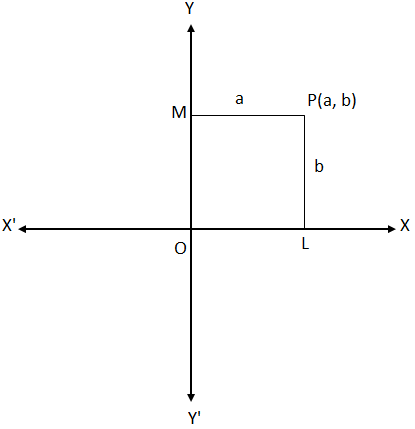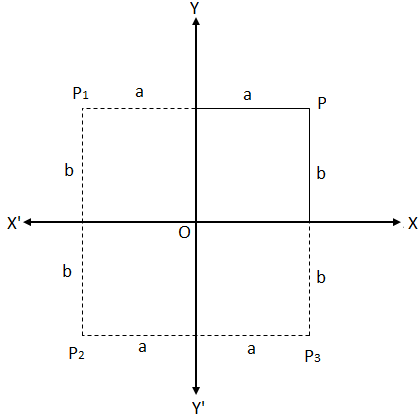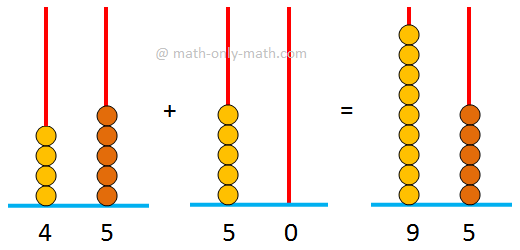Rectangular Cartesian Coordinates of a Point
Take two intersecting lines XOX’ and YOY” in a plane which cut at O and are perpendicular to each other. Let P be a point in the plane. Draw perpendiculars from P to the line XoX’ and YoY’.
Let them be PL and PM. Measure PL and PM in the same scale in mm, cm or m, etc. Let the measures of PL and PM be b units and a units respectively. Then (a, b) are called rectangular Cartesian coordinates of a point P.
The lines XOX’ and YOY’, called coordinate axes, together from the frame of reference in the Cartesian x-y plane for which
(i) XOX’ in called the x-axis,
(ii) YOY’ is called the y-axis, and
(iii) O is called the origin.
If (a, b) are the coordinates of the point P then a is called the x-coordinate or abscissa and b is called the y-coordinate or ordinate of a point P.
In the discussion above, we have seen that to determine the coordinates of the point P, we need to measure the lengths of PM and PL. We have found that the measures are a units and b units respectively.
But with the same measures of distances, the point P can be found in any of the three other positions in the same plane as shown in the adjoining diagram.
To determine the exact position of a point in a plane, we need to undedrstand the convention for signs of coordinates.
From Rectangular Cartesian Coordinates of a Point to HOME PAGE
Didn't find what you were looking for? Or want to know more information about Math Only Math. Use this Google Search to find what you need.
Recent Articles
-
Adding 2-Digit Numbers | Add Two Two-Digit Numbers without Carrying
Mar 23, 25 12:43 PM
Here we will learn adding 2-digit numbers without regrouping and start working with easy numbers to get acquainted with the addition of two numbers. -
Worksheet on 12 Times Table | Printable Multiplication Table | Video
Mar 23, 25 10:28 AM
Worksheet on 12 times table can be printed out. Homeschoolers can also use these multiplication table sheets to practice at home. -
Vertical Subtraction | Examples | Word Problems| Video |Column Method
Mar 22, 25 05:20 PM
Vertical subtraction of 1-digit number are done by arranging the numbers column wise i.e., one number under the other number. How to subtract 1-digit number vertically? -
Worksheet on 11 Times Table | Printable Multiplication Table | Video
Mar 22, 25 05:08 PM
Worksheet on 11 times table can be printed out. Homeschoolers can also use these multiplication table sheets to practice at home. -
Worksheet on 10 Times Table | Printable Multiplication Table | Video
Mar 21, 25 03:46 PM
Worksheet on 10 times table can be printed out. Homeschoolers can also use these multiplication table sheets to practice at home.








New! Comments
Have your say about what you just read! Leave me a comment in the box below. Ask a Question or Answer a Question.